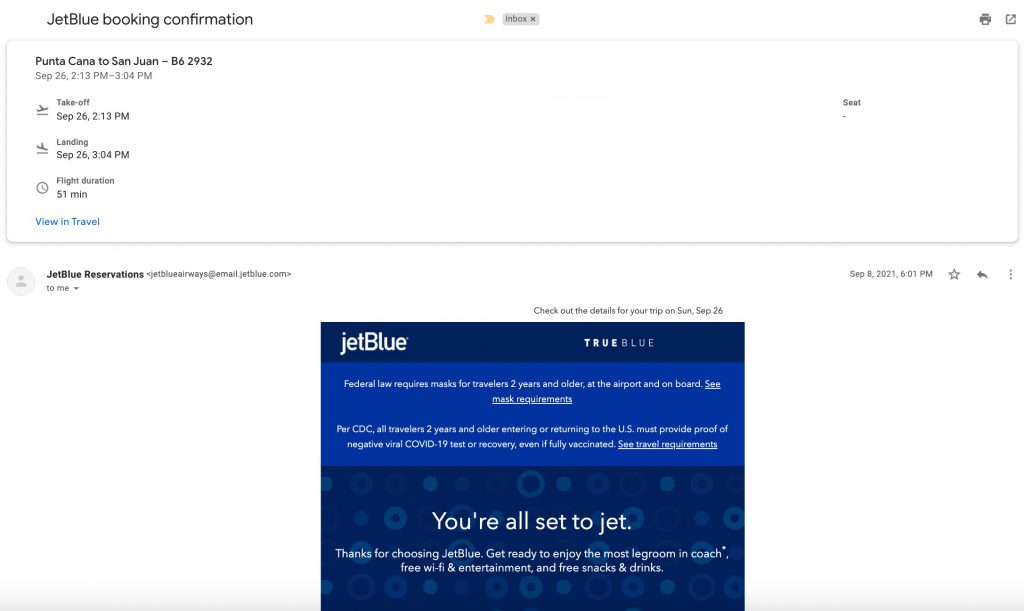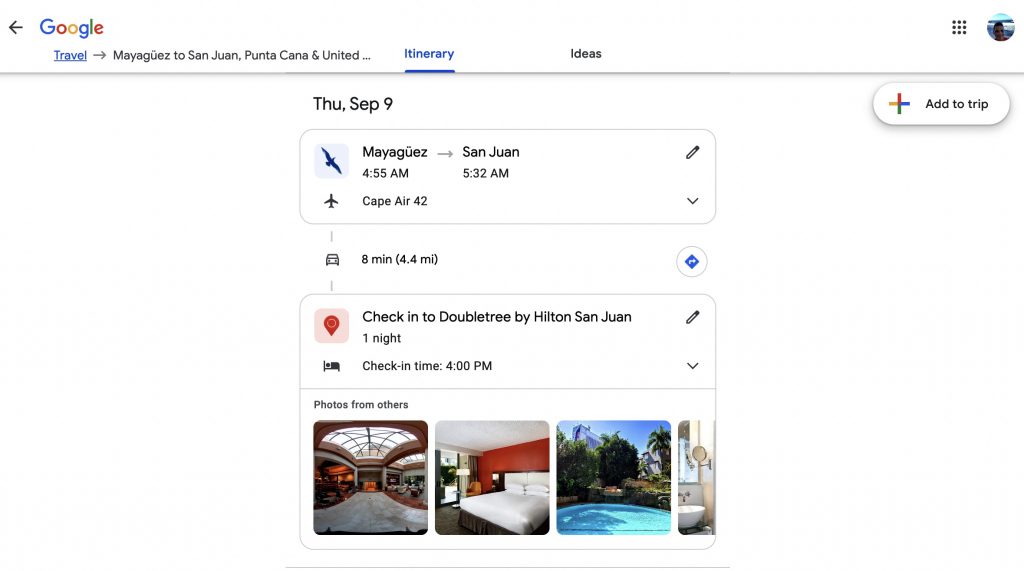Skift Take
Google's Gmail itinerary feature can be helpful to travelers — up to a point. But Google's execution of it is deceptive, and a disservice to its travel partners.
If you are a Gmail user and you book a United Airlines flight, an Avis car rental, or an Expedia vacation package, Google adds a module to your confirmation emails with a link to your itinerary in Google Travel.
In some ways, it’s a cool feature for travelers: You click on a link in the module labeled “View in Travel,” and you navigate from Gmail to Google Travel, where you can easily view all of your JetBlue flight information, as well as perhaps a Marriott hotel or Hertz car rental reservation, and past and other future itineraries. Google Travel is the section of Google.com where it offers flights, hotels, vacation rentals and things to do.
Many consumers undoubtably like the convenience of this Gmail to Google.com itinerary feature.
There’s no great public outcry among travel companies against it, but there are several transparency and related issues regarding this product from Google, which owns Gmail.
The module is tacked onto the supplier confirmation email in Gmail. Even though it appears higher than the supplier sender and timestamp information in the email, it is arguably deceptive and confusing to some travelers because there is nothing in the module that labels it as coming from Google.
It can appear as though the extra module was sent by HotelTonight or JetBlue. For example, a recent Google module we received attached to a HotelTonight email is labeled “HotelTonight Booking receipt,” or another is designated as “Expedia travel confirmation” and there was no indication that Google, and not HotelTonight or Expedia, was the sender.
“Google’s unsolicited promotion of other travel sellers within a traveler’s email confirmation appears to be an attempt to hijack the consumer,” said Henry Harteveldt of Atmosphere Research Group. “Just because Google may have the technology to do this, and perhaps within its Gmail terms and conditions the legal right to do this, doesn’t mean they should do this.”
Here’s an example of a Google module in Gmail that is added onto a JetBlue confirmation email. Everything below View in Travel comes from JetBlue but the top unidentified part that is labeled “JetBlue booking confirmation” comes from Google, not JetBlue. And it is getting a free ride atop the actual JetBlue confirmation that begins with the JetBlue sender information and email timestamp.

When you click the View in Travel link — which comes from Google, but how would you know? — you navigate to Google.com to view itinerary information in Google Travel, one of the main focuses of the search engine’s travel business. The next image shows itinerary information in Google Travel about a user’s Cape Air flight information and a Doubletree hotel booking. It’s handy to have all that information in one place, but not very convenient if you clicked on the link thinking you’d end up on CapeAir.com or another supplier site.

For airlines, hotels, or online travel agencies seeking to nurture one-to-one relationships with their customers, this Google add-on feature is a definite detour and roadblock.
Harteveldt of Atmosphere Research argued that it would be more customer-centric for Google to invite Gmail users to participate in the program and give them the choice of opting-in or out instead of diverting them to Google Travel without openly directing them there.
Google indeed gives users the option of disabling the feature here under “Smart features and personalization in other Google products,” but how many travelers will bother to do so to combat the annoyance of being misdirected to Google instead of immediately to the supplier? We concede, though, that some travelers love the feature.
When viewing your itineraries in Google Travel, you can’t do anything to actually alter the trip there so Google isn’t interfering with supplier operations in that sense. And it runs tests to ensure that consumers aren’t confused by the supplementary module tacked onto the reservation confirmation.
“We haven’t seen any indication that this feature is confusing for users,” Google stated to Skift. “On the contrary, we’ve heard lots of positive feedback from people who want an easy way to keep track of their travel plans.”
Well, here’s an indication that it can be confusing: I’ve personally clicked on the link in the module/supplier emails several times, and expected to end up on an airline or online travel agency website, and found myself on Google instead. There is nothing in the module that identifies it as being sent by Google, so it is deceptive in that sense, and it interfered with my desire to get to the supplier website to change a flight or seat selection.
Reservation confirmation emails from suppliers tend to have buttons in them to enable the customer to manage their bookings. During the Covid era, when many travel businesses are offering a degree of flexibility so consumers can change their reservations as needed, the Google module added to supplier emails can be a nuisance and diversion, and deters from suppliers’ desire to keep their customers engaged on their own websites.
Skift reached out to a half dozen suppliers, including JetBlue, United, Avis Budget, Booking.com and Expedia, and none provided an on-the-record comment about the Google feature.
It’s a self-important and arrogant gesture on Google’s part that instead of advising Gmail users to view the link in Google Travel it merely tells them to view the confirmation in “Travel.” What does that mean? Does Google now own Travel?
In some ways, it would like to.
The Daily Newsletter
Our daily coverage of the global travel industry. Written by editors and analysts from across Skift’s brands.
Have a confidential tip for Skift? Get in touch
Tags: google, google travel, jetblue airways, online travel agencies, united airlines
Photo credit: Google's Richard Holden (right) speaks with Skift's Seth Borko at Skift Global Forum in New York in September 2021.
